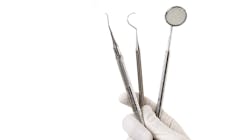Strategies to triple your dental hygiene revenues in 3 years
It may seem impossible to thrive in today’s economic and employment climate. While inflation, increased wages and supply costs, and inadequate reimbursements from third-party payers certainly challenge our success, practices can still prosper. Here I share my story and strategies that have proven to be practice-altering.
A little background …
At some point during my 12-week shutdown in 2020, I decided that my practice was going to change. What aspects of my practice? Everything. I had bought it six years prior, and while I had implemented some new technologies, it became clear that my vision for and reality of my practice were nowhere near consistent. I decided that I needed to make significant changes to my dental team and the way we deliver patient care. I consistently keep up with CE and dental materials from a restorative perspective, so I decided that this overhaul was going to start in the dental hygiene department.
You might also be interested in ...
Practice production, prioritized: Hygiene productivity
Add value to your practice—especially if you're thinking of selling
At the time, my hygiene “department” consisted of one dental hygienist who maintained part-time hours. I made these changes because I believed that it was the right thing to do. My patients deserve the best, and since my name is on the door of my practice, it was time to do things my way. Little did I know, my entire practice was about to change.
Since 2020, my one part-time hygienist practice has grown to employ four hygienists. Due to a variety of reasons and outside commitments, they all work part-time hours. As of 2022, the revenues from the hygiene department have tripled (table 1). I am particularly proud of this, as my vision is coming to reality.
While we’ll always have work to do and improvements to make—for example, it seems like I’ll be hiring on a continual basis—here’s how we increased our hygiene revenues.
Attract the right team members
- Tell everyone that you are hiring. I was introduced to every exceptional team member in my practice by word-of-mouth.
- Create a mission statement and a vision for the practice and stay laser-focused on it. Share it with prospective team members and only hire those who share your vision.
- Hire slowly, fire quickly. Just as we all must kiss some frogs before we find our ideal partner, the same goes for the team: once you identify a frog, let them hop away!
Let scientific evidence support your philosophy
While this could be an article all by itself, here’s some food for thought:
- Nearly 50% of all Americans over 30 years old have some form of periodontal disease.1 Now, run a report in your practice management software. In 2019, only 5.7% of my patients were treated as perio patients. If you have similar stats, you have a significant opportunity for growth right there in your practice.
- Clinical signs of periodontal disease include biofilm dysbiosis, increased pocket depths, attachment loss, and bleeding on probing.2 When patients present with signs of disease, it is vital to address them, as oral inflammation is implicated in the worsening of multiple systemic illnesses.3,4 This includes maintaining a shorter recall frequency, localized or quadrant scaling and root planing, localized therapies, oral hygiene instructions, and product recommendations.
Once you have the right team ...
Invest in them and invest in technology. Modern technology facilitates excellent patient communication and enhances the acceptance of care recommendations. Technologies that have greatly enhanced our patient experience and case acceptance include:
- Voice-activated periodontal charting (Voiceworks, Florida Probe) engages patients in the diagnosis, progression, and management of gingival and periodontal diseases.
- Guided biofilm therapy (GBT) is a systematic, evidence-based approach to the management of periodontal disease and gingivitis. This includes a step-by-step approach to the dental hygiene appointment and encourages patient engagement and interaction—i.e., assessments, including the identification of biofilm via disclosing agents (Tri Plaque ID, GC America), home-care recommendations, and complete biofilm and calculus removal with the AirFLOW Prophylaxis Master, PerioFLOW, and Piezon. This highly efficient system promotes a superior patient experience.
- Intraoral photography is essential for patient education. The use of verbal descriptions to explain a dental condition won’t cut it. Photos are highly effective communication tools. Excellent intraoral cameras include (but are not limited to) DEXCam 4 HD, MouthWatch, and Acteon. Other successful uses of intraoral cameras include demonstrating worn, fractured, or crowded teeth; failed restorations; obvious caries, biofilm, and calculus; and as a tool to celebrate dramatic transformations, whether a small composite restoration or crowns.
- Intraoral scanning. Dental hygienists can add intraoral scanning to their appointments as education tools for patients, to aid in smile design, monitoring tooth volume and position, or as a digital impression for diagnostic casts, wax-ups, and preparation for indirect restorative procedures. In addition, patients can be scanned for various appliances, including bruxism appliances, sleep appliances, clear aligners, orthodontic retainers, take-home bleaching trays (e.g., Zoom at home, Philips), and tooth replacements with removable or fixed prostheses.
- Autonomy. Providing hygienists with autonomy will ultimately improve the oral health of your patients. Consider shortening the recall intervals for all patients who present with bleeding upon probing. If permitted by your state, the administration of local anesthetic by hygienists can enhance the efficiency and ultimately the profitability of the dentist.
- Education. Spend time educating your hygienist about your approach to care. For example, if your hygienist understands when you recommend a crown versus a composite, they can provide patients with information that aligns with your recommendations. A consistent message is vital for proper informed consent, treatment acceptance, and an efficient periodic exam.
Consider adjunct therapies
Many patients benefit from additional therapies to maintain their periodontal health:
- Perio Protect trays deliver hydrogen peroxide-based medicament to the base of the periodontal pocket to manage biofilm that routine at-home hygiene practices cannot access.
- Nonsurgical laser therapy. Lasers can be used in the dental hygiene operatory to decontaminate periodontal pockets, for debridement, for management of aphthous ulcers and herpetic lesions, and for hemostasis.
- Bacterial testing. Identifying the causative microorganisms and providing targeted therapy will help patients manage periodontal disease. We have implemented OraVital bacterial testing in our practice. It takes approximately five minutes to collect the sample. The test is then sent to the lab, and a report identifies the predominant bacteria, fungi, or viruses that are contributing to the patient’s periodontal condition.
- Product distribution. Making recommendations for optimal at-home practices include recommending specific dental products. Distributing recommended products, including electric toothbrushes, water flossers, toothpaste, and oral rinses, offers convenience for patients. Moreover, offering specific products ensures that patients obtain the products specifically recommended for them, allowing for proper follow-up.
- Oral probiotics can help facilitate a healthy oral environment. Many perio therapies are initiated to remove pathogenic bacteria, but oral probiotics will serve to improve the quantity of beneficial bacteria.
- Fluoride varnish applications. In my practice, I have identified that most patients are at risk for dental caries. Common risk factors include (but are not limited to) xerostomia-inducing medications, caries incidence, demineralization, and a heavily restored dentition.5 These patients will benefit from a fluoride varnish application.6
Be creative and inclusive
Consider your hygiene colleagues as partners in oral health.
- Many dentists are considering providing their own dental hygiene services due to the shortage of dental hygienists and the increase in wage demands. This can serve as a short-term solution, but it isn’t profitable for a dentist to be providing dental hygiene procedures.
- Create a culture that is consistent with your vision but that empowers the dental hygienist to be challenged, valued, and profitable. Providing a D1110 every six months on a periodontally unhealthy patient is disheartening for hygienists, ineffective for patients, and unproductive for the practice.
- Consider flexible hours. As my dental hygiene department grows, I offer additional time to my current hygienists, but I also consider adding additional part-time hygienists to support practice growth.
- I rely on my dental hygienists to encourage health for my restorative patients. This includes providing routine dental hygiene procedures and adjunctive therapies, and scheduling patients for biofilm removal prior to preparation, final impressions, and delivery of esthetic indirect restorations. This promotes a favorable environment for my procedures and offers patients additional opportunities to refine their at-home oral hygiene practices. This partnership with the dental hygienist is professionally satisfying and profitable for the practice.
Ensuring practice success
The current times are undoubtedly challenging. However, when the dental team shares your vision and maintains a steadfast commitment to improve the oral health of patients, your practice can flourish despite today’s economic challenges. When team culture is prioritized and technology is employed to support the mission of the practice, practice profitability will follow.
Editor's note: This article appeared in the April 2023 print edition of Dental Economics magazine. Dentists in North America are eligible for a complimentary print subscription. Sign up here.
References
- Eke PI, Dye BA, Wei L, et al. Update on prevalence of periodontitis in adults in the United States: NHANES 2009 to 2012. J Periodontol. 2015;86(5):611-622. doi:10.1902/jop.2015.140520
- Papapanou PN, Sanz M, Buduneli N, et al. Periodontitis: consensus report of workgroup 2 of the 2017 World Workshop on the Classification of Periodontal and Peri-implant Diseases and Conditions. J Clin Periodontol. 2018;45(Suppl 20):S162-S170. doi:10.1111/jcpe.12946
- Meurman JH, Bascones-Martinez A. Oral infections and systemic health – more than just links to cardiovascular diseases. Oral Health Prev Dent. 2021;19(1):441-448. doi:10.3290/j.ohpd.b1993965
- Graves DT, Corrêa JD, Silva TA. The oral microbiota is modified by systemic diseases. J Dent Res. 2019;98(2):148-156. doi:10.1177/0022034518805739
- Maragliano-Muniz PM, Roberts DR, Chapman RJ. Trends in dental hygiene: clinical results and profitability of a caries-management program in private practice. RDH. December 1, 2012. https://www.rdhmag.com/career-profession/students/article/16405921/trends-in-dental-hygiene
- Urquhart O, Tampi MP, Pilcher L, et al. Nonrestorative treatments for caries: systematic review and network meta-analysis. J Dent Res. 2019;98(1):14-26. doi:10.1177/0022034518800014
About the Author
Pamela Maragliano, DMD
Chief Editor of Dental Economics
Pamela Maragliano, DMD, is the chief editor of Dental Economics. Based in Salem, Massachusetts, Dr. Maragliano began her clinical career as a dental hygienist. She went on to attend Tufts University School of Dental Medicine, where she earned her doctorate in dental medicine. She then attended the University of California, Los Angeles, School of Dental Medicine, where she became board-certified in prosthodontics. Dr. Maragliano owns a private practice, Salem Dental Arts, and lectures on a variety of clinical topics. You may contact her at [email protected].


